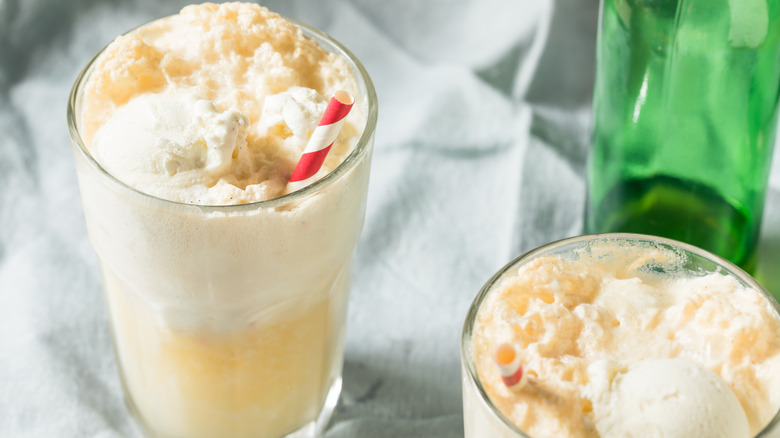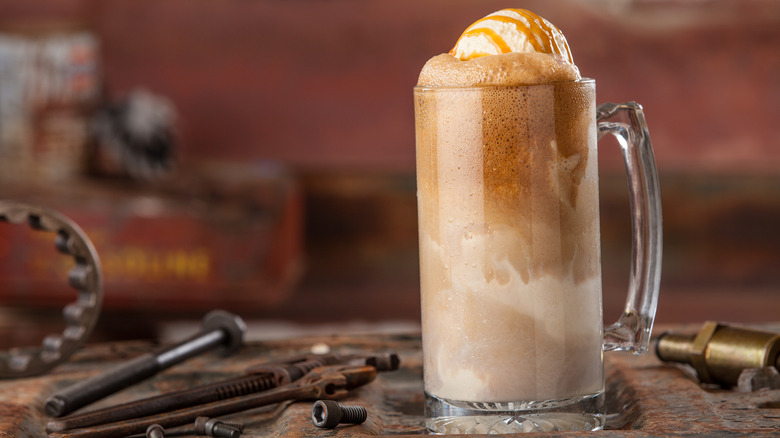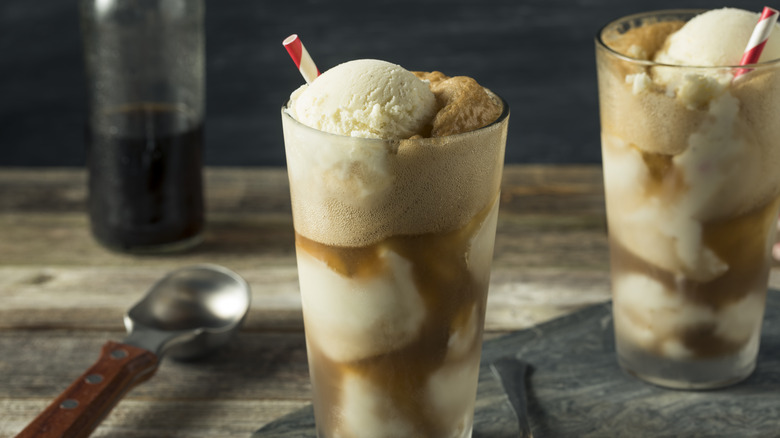The Boston Cooler Is An Iconic Drink With A Confusing Origin
We may receive a commission on purchases made from links.
The Boston Cooler is obviously the drink you'll find served at restaurants and bars all across Boston, right? Not exactly, because history is strange, and we live in a time where nothing makes sense. If you want to visit the city that serves the best Boston Coolers, that means taking a trip to Detroit, Michigan. But why?
Each state has its own signature soda, and when you're talking about Michigan, that's Vernors. Vernors is actually one of the oldest sodas in the country, a Civil War-era product that was initially sold by James Vernor in his combination pharmacy and soda fountain. Any Detroit native will tell you that it's Vernors ginger ale that makes a truly authentic Boston Cooler, and interestingly, it's ginger that was a key ingredient in the first batches of Vernor's sodas. Add ice cream to Vernors ginger ale, and you have a Boston Cooler. But whatever you do, don't call it a float. The difference is important: Floats are typically served with soda poured over the ice cream, but in a Boston Cooler, everything's mixed together to make it more like an extra creamy ginger milkshake.
Some who take their Boston Coolers very seriously will insist that, along with Vernors, only a specific, regional ice cream is used: Stroh's. But why on Earth is it named after another city? It's a weird story.
The Boston Cooler was once an entirely different drink
The Boston Cooler was originally a Massachusetts native that first gained traction in the late 19th century — not too far removed from the time Vernors soda was becoming a Michigan favorite. Details are sketchy, but the original drink was an alcoholic beverage that mixed soda water and lime with rum. It seems to have gone through a few variations even as the name stuck, and it's unclear how it turned into the ginger ale and ice cream drink it is today.
At least, that's one possibility. There are a few other theories as to why this Detroit staple was named for Boston, and some suggest it was actually named after areas in Detroit. Boston Boulevard isn't far from where James Vernor started selling his soda, and there's also the city's Boston Edison neighborhood. Nothing has ever been proven, though, and the precise origins of this long-time favorite are still disputed.
However, it seems as though "Boston Cooler" was once used as a generic name for a float. It popped up throughout the early 1900s and was used to describe various drinks made with ice cream, and one of the first mentions of the term was in an advertisement in the St. Louis Post-Dispatch. But, more confusingly, the ad claimed the term was first used by a New York barman. When Vernors adopted it, it defined the drink as being made with its ginger ale and ice cream.
Some recipes put booze back in the Boston Cooler
Today, some recipes put the liquor back into this creamy, foamy beverage. A shot of vodka is the easiest way to turn this family favorite into an adults-only drink, as its neutral flavor won't overpower or conflict with the spicy ginger of the soda.
Alternatively, whiskey is another great option. After all, a whiskey ginger cocktail is a simple drink that calls for just ginger ale and whiskey, so it makes sense that the combination works when ice cream is added to the mix. Similarly, rum and ginger can be a delicious combination, as evidenced by the black and ginger cocktail. Fortunately, we don't have to know the history of this Detroit favorite to enjoy it, but there is one more interesting footnote to this story that connects Detroit, Boston, and Vernors in a strange way that seems to be a complete coincidence.
We'd also like to point out that the mascot for Vernors bears a striking resemblance to the Boston Celtics mascot ... and that the happy little chap serving up Vernors soda actually predates the Celtics' Lucky the Leprechaun by decades. Vernors' mascot is technically described as a gnome, although it's easy to see how he might be mistaken for a leprechaun with his green clothes, buckled hat, and big red beard. He made his first appearance in the early 1900s, while the Celtics adopted their leprechaun in the 1950s.


